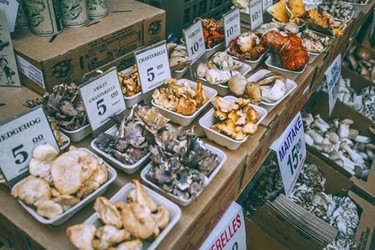
There’s no denying that consuming raw mushrooms may sound like a bad idea but is there truth to it? Can you eat raw mushrooms? Are they safe for consumption? If so, which mushroom species can you eat? In this guide, we’ll delve into these questions and more. You’ll also understand why a multitude of people is averse to the consumption of raw mushrooms. Read on!
Image: Raw assorted mushrooms
What Do Mushrooms Consist Of?
Let’s discuss the white mushroom as it’s arguably the most common type you’ll find in your home and on the shelves. If you’re uncertain what mushrooms are, they are the button, champignons, table, or Portobello counterparts.
Additionally, you can find the brown-capped options that have the same nutritional makeup as white mushrooms and are stocked right next to each other.
Alongside these mushroom species are oyster mushrooms that are large, wide, and have the perfect texture making them ideal meat substitutes. According to the USFDA, 100 grams of white raw mushrooms consist of the following.
- 1g dietary fiber
- 34g fat
- 45g water (like most veggies)
- 09g protein
- 26g carbohydrates
There’s not much that will sit badly or hurt if you consume raw mushrooms. Furthermore, if you’ve cooked mushrooms, you know they shrink considerably and give plenty of water when cooked. However, what most people have concerns about is agaritine. In a nutshell, it’s a naturally occurring compound that’s been tied to cancer by altering the DNA structure.
Furthermore, agaritine is found in freshly picked mushrooms. Nonetheless, its levels diminish when it’s subjected to storage or cooking. Therefore, refrigeration coupled with high heat will make the levels go down considerably, as will storage of the mushrooms. Provided that your mushrooms are store-bought, they’ve been stored and refrigerated for a few days before they make it to your fridge.
Keeping that in mind, if you’re growing your mushrooms and have just hand-picked them, then they may have more levels of agaritine.
Can You Eat Raw Mushrooms?
Yes! Uncooked mushrooms are safe for consumption, for the most part. Although that refers to the common white button species, it can apply to nearly all edible mushrooms, provided that you’re comfortable with the texture and flavor.
Is It Safe To Consume Raw Mushrooms?
Factoring in the presence of agaritine in mushrooms, consider how often you consume them. Furthermore, of those times, think about how often you’re inclined to think they are better raw or cooked. For example, if you’re whipping up a salad, then you’ll want to eat them raw as they blend well that way.
Contrarily, if you’re cooking any recipe that requires the addition of mushrooms, then you’re likely to consume them cooked. After all, they are an essential ingredient in your recipe. If you’re vegan or the consumption of fresh and raw mushrooms is a major part of your diet, then it boils down to deciding whether or not agaritine is worth fretting over.
The Texture of Raw Mushrooms
Circling back to texture, it’s important to ask yourself whether you prefer to consume raw mushrooms or cook them. If you’ve eaten cooked mushrooms before, then you’re familiar with their soft texture.
However, consuming them raw is an entirely different ballgame as they won’t be as soft, and they differ in flavor. You’ll notice they are stronger and earthier, which might not appeal to your palette.
Nonetheless, if you gravitate towards mushrooms, then you’ll likely revel in their rawness. Those who prefer to drown mushrooms in garlic for that burst of flavor won’t enjoy them as much.
Are Mushrooms Healthier Raw or Cooked?
From a given standpoint, mushrooms are healthier when cooked rather than eaten raw due to the levels of agaritine. Additionally, that’s due to their sturdy and tough cell walls that are a beast at locking in the wealth of nutrients.
Heat breaks down the walls and facilitates better absorption by the body. As such, you’ll still get enhanced nutritional benefits from raw mushrooms but not as much as when you cook them.
Furthermore, you should take a step back and look at your diet. If nutrition is your goal, then three medium-sized Portobello once every week won’t impact your diet. Diet and nutrition are complex, and you require consistency for a positive outcome.
Like the numerous health benefits that stem from consistently taking supplements and green tea, being inconsistent with them will prove futile.
How to Safely Eat Mushrooms
The safe consumption of mushrooms entails:
- Consuming mushroom products or mushrooms that have been heat-treated or cooked.
- Proper treatment that softens fungal tissues, denatures toxins, and paves the way for your natural digestive enzymes to access and make use of the inherent perks of mushroom supplements and culinary mushrooms.
- Edible mushrooms should be tenderized via 140˚F of heat for 3 to 4 hours but more preferably above 200˚F to release their nutrients and render them safe and digestible.
What Mushrooms Can You Eat Raw?
Here are some of the edible mushrooms that can be eaten raw. Although they can be eaten raw, we recommend considering the significant difference in texture and flavor as it’s a big adjustment from cooked mushrooms.
Oyster Mushroom
Although they can be eaten raw, oyster mushrooms are tougher and need some cooking to soften. They are the most cultivated edible mushroom rather than foraged as they thrive in nearly all environments. Oyster mushrooms are best cooked with a boatload of herbs, courtesy of their mild, meaty flavor.
Champignon, White, or Brown Mushroom
These mushroom species are safe to eat raw provided that you wash them thoroughly and inspect them between their gills. Keep in mind that they have a bold, earthy flavor that may not appeal to your palette.
Furthermore, they have the highest levels of agaritine in their raw form. If you opt to cook them, their versatile nature makes them compatible with various recipes ranging from stews, risottos, and soups. They can be eaten as is, in a sauce, or pan-fried.
Portobello Mushroom
It’s a fully mature brown and white mushroom species. While Portobello is safe for raw consumption, you’ll enjoy the burst of flavor when pan-fried with plenty of rosemary and garlic. It can handle any form of cooking.
Shiitake Mushroom
They form an essential part of Asian cuisine, with the dried stems adding a kick to sauces, broths, stocks, and soups. While Shiitake mushrooms can be eaten raw, it’s worth noting that they may trigger rashes in people susceptible to allergies. Furthermore, it’s advisable to cook them to tap into their bold, earthy flavor.
Porcini Mushroom
Also known as Penny Bun, Porcini are tougher mushrooms that require cooking to soften up their sturdy exterior. They typically pop up around pine trees after the first winter rains. While you can still enjoy them raw, the distinct, nutty, and earthy flavor is amplified when cooked.
Shimeji Mushroom
Their tight concave caps coupled with long stems set Shimeji mushrooms apart from the pack. While you have free rein to consume them raw, if you do so, you may notice they are more difficult to digest, which is why they are better cooked.
When cooking Shimeji mushrooms, they respond well to low, slow, high, or quick methods, allowing you to pop them in a braise or fry them.
The Verdict: Can You Eat Raw Mushrooms?
Although you can eat a raw mushroom, to be completely safe, you’ll need to cook them. Doing so kills spores, bacteria, or viruses and prevents them from dying off if they’re kept at high heat for several minutes.
Therefore, cooking a raw mushroom from a food safety standpoint is ideal. Nonetheless, the ball is in your court despite the difference in flavor and texture, so it boils down to your preference whether you want to eat them raw or cook them.
Lastly, when it comes to agaritine, consider how often you consume mushrooms, the quantity you eat, and the type. If your general intake is low, then it’s safe for you to eat them raw.




